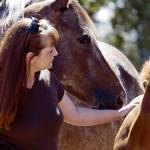Reducing Your Horse’s Environmental Hoofprint

Consideration of “carbon footprints” is becoming more and more important, encouraging us to make more ecologically sound decisions, such as choosing to reduce, reuse, and recycle, turning lights out, and buying greener products. Did you know your horse also has an environmental “hoofprint?”
One obvious way to control both feeding costs and environmental hoofprints in horses is to decrease “inputs.”For example, horses that are fed cereals rather than only grass create an environmental hoofprint. This is because cereals need water and fertilizers; energy for sowing and harvesting is required; and cereals for horses utilize land that could instead be used for human food supply. In addition, feeding horses is expensive; an estimated 20–50% of costs associated with horse farming are related to feeding.
One obvious way to control both feeding costs and environmental hoofprints in horses is to decrease “inputs.” What’s not so obvious is how to achieve this. According to one group of French researchers*, there are alternate practices that horse owners could consider to decrease feeding costs while maintaining performance. One such method is to decrease global supplementation. For example, many horses with high energy demands, such as lactating mares, are capable of thriving on forage (i.e., hay, pasture) but they are frequently supplemented with concentrates to ensure adequate production and performance. To prove that horses with high energy demands can flourish while grazing only, the researchers rotationally grazed 16 lactating saddle mares on permanent pastures over three vegetation cycles. Half of the mares were supplemented with barley and the other mares remained unsupplemented.
In both groups, all mares met their energy requirements, maintained a body condition score greater than 3, and produced foals with satisfying growth rates and conformation. This study therefore demonstrated that mares can be maintained on pasture only, and that even in horses with high energy demands, supplementation with concentrates should not be systematic.
The lack of “routine” supplementation appears to be an efficient way to decrease costs associated with feeding, and can also decrease each horse’s environmental hoofprint.
*Collas, C., G. Fleurance, J. Cabaret, et al. 2014. How does the suppression of energy supplementation affect herbage intake, performance and parasitism in lactating saddle mares?Animal Jun 2:1–8.








